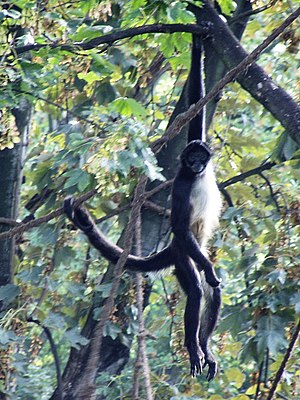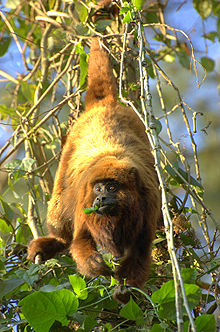Clamp-tailed monkeys
| Clamp-tailed monkeys | ||||||||||||
|---|---|---|---|---|---|---|---|---|---|---|---|---|

Geoffroy's spider monkey ( Ateles geoffroyi ) |
||||||||||||
| Systematics | ||||||||||||
|
||||||||||||
| Scientific name | ||||||||||||
| Atelidae | ||||||||||||
| Gray , 1825 |
The spotted monkeys ( Atelidae) are a primate family from the group of the New World monkeys (Platyrrhini). They get their name from their prehensile tail. Spider-tailed monkeys live in Central and South America and are predominantly herbivorous tree dwellers. The family includes over 25 species in five genera, including spider monkeys , spider monkeys , woolly monkeys , and howler monkeys .
features
Clamp-tailed monkeys reach a head body length of 30 to 80 centimeters, the tail becomes up to 90 centimeters long. The weight is between 5 and 15 kilograms. The largest representatives are the spider and howler monkeys, the largest primates on the American continent. Usually there is a clear sexual dimorphism in terms of size - males are significantly heavier than females, and sometimes also in terms of coat color. The color of the fur varies depending on the species and habitat between different shades of gray, red, brown or black. The limbs are relatively long, the hands hook-shaped and the thumbs sometimes retracted. The tail, which is as long as the body, serves as a prehensile tail: the rear part of the underside is hairless and developed as a tactile skin area. In some species, the females have penis-like clitorides . The dental formula of atelidae is like most New World monkeys I 2/2, C 1/1, P 3/3, M 3/3, a total they have 36 teeth.
distribution and habitat
Spiked-tailed monkeys only occur on the American continent , their range extends from southern Mexico to Bolivia and southern Brazil . They are all forest dwellers who live in different forest types. Some representatives like the spider monkeys are dependent on primary forests , while howler monkeys can also live in deciduous forests and even savanna-like habitats.
Way of life
Spider-tailed monkeys are diurnal and mostly stay in the trees, only occasionally they come to the ground. Movement in the branches takes place on all fours or in a swinging way. The spider monkeys and spider monkeys in particular show great skill and are similar in their locomotion to the gibbons, which are not closely related .
These primates live in groups that are usually composed of several males and females and can contain up to 100 animals. Sometimes they split up into smaller subgroups in their daily foraging for food. Some of the groups inhabit huge areas where they are (over 1000 hectares for woolly monkeys), but usually do not show any pronounced territorial behavior. Also within the group - compared to other primates - there is a rather peaceful and less aggressive interaction with one another, especially with spider monkeys.
Communication by means of loud shouting plays an important role. It is used to inform other groups of your own whereabouts and thus to avoid collisions or to find the other group members. This screaming behavior is particularly pronounced in howler monkeys, which are equipped with enlarged hyoid bone and thyroid cartilage for loud screams.
food
Claw-tailed monkeys are herbivores, but the composition of the diet varies by species and season. Howler monkeys, and to a lesser extent spider monkeys, are leaf-eaters - like many other leaf-eating mammals, they take long breaks to compensate for the low nutritional value of their food. Spider monkeys and woolly monkeys, on the other hand, feed mostly on fruits. Flowers, seeds and other plant material also play a role. They also eat insects and other small animals to a lesser extent.
Reproduction
Spotty-tailed monkeys are generally characterized by a very low reproductive rate, with the female only giving birth to a young every few years. The gestation period is six to eight months, the litter size usually one. The rearing of the young is predominantly or entirely the responsibility of the female. The boy is weaned after one to two years, and puberty occurs after four to seven years. They are rather long-lived animals that, at least in human care, can live for several decades.
Danger
Like many other forest-dwelling animals in Latin America, many spider-tailed monkeys suffer from the ongoing destruction of their habitat - habitat specialists in particular are affected. In addition, they are hunted for their meat - their large size makes them a worthwhile target for hunters. The IUCN lists most species as endangered or threatened.
Systematics
The spiked-tailed monkeys are counted among the New World monkeys (Platyrrhini), their closest relatives are likely to be the Sakia monkeys .
The family includes over 25 species in five genera:
- The seven species of spider monkeys ( Ateles ) are fast and skilful climbers with remarkably long limbs:
- White- fronted spider monkey ( Ateles belzebuth )
- Black- faced spider monkey ( A. chamek )
- Brown-headed spider monkey ( A. fusciceps )
- Geoffroy's spider monkey ( A. geoffroyi )
- Brown spider monkey ( A. hybridus )
- White-cheeked spider monkey ( A. marginatus )
- Red-faced spider monkey ( A. paniscus )
- The two species of spider monkeys ( Brachyteles ) of south-east Brazil are among the most threatened primate species:
- Northern spider monkey ( Brachyteles hypoxanthus )
- Southern spider monkey ( B. arachnoides )
- The four species of woolly monkey ( Lagothrix ) from northwestern South America are characterized by their dark, woolly fur:
- Gray woolly monkey ( Lagothrix cana )
- Brown woolly monkey ( L. lagotricha )
- Colombian woolly monkey ( L. lugens )
- Silver woolly monkey ( L. poeppigii )
- The yellow-tailed woolly monkey ( Oreonax flavicauda ) is the only representative of the genus Oreonax and lives exclusively in northern Peru.
- The twelve species of howler monkeys ( Alouatta ) are characterized by their loud screams:
- Howler Monkey ( Alouatta arctoidea )
- Red-handed howler monkey ( Alouatta belzebul )
- Black Howler Monkey ( Alouatta caraya )
- Spix howler monkey ( Alouatta discolor )
- Brown Howler Monkey ( Alouatta guariba )
- Guyana Howler Monkey ( Alouatta macconnelli )
- Amazonian black howler monkey ( Alouatta nigerrima )
- Mantled Howler Monkey ( Alouatta palliata )
- Guatemala Howler Monkey ( Alouatta pigra )
- Bolivian Howler Monkey ( Alouatta sara )
- Red Howler Monkey ( Alouatta seniculus )
- Maranhão Howler Monkey ( Alouatta ululata )
The howler monkeys form the subfamily Alouattinae, while the other genera are grouped together as Atelinae. A possible cladogram looks like this (according to Geissmann, 2003):
| Spike-tailed monkeys (Atelidae) |
|
||||||||||||||||||||||||
|
|
literature
- Thomas Geissmann : Comparative Primatology. Springer-Verlag, Berlin et al. 2003, ISBN 3-540-43645-6 .
- Don E. Wilson, DeeAnn M. Reeder (Eds.): Mammal Species of the World. A taxonomic and geographic Reference. Johns Hopkins University Press, Baltimore MD 2005, ISBN 0-8018-8221-4 .


